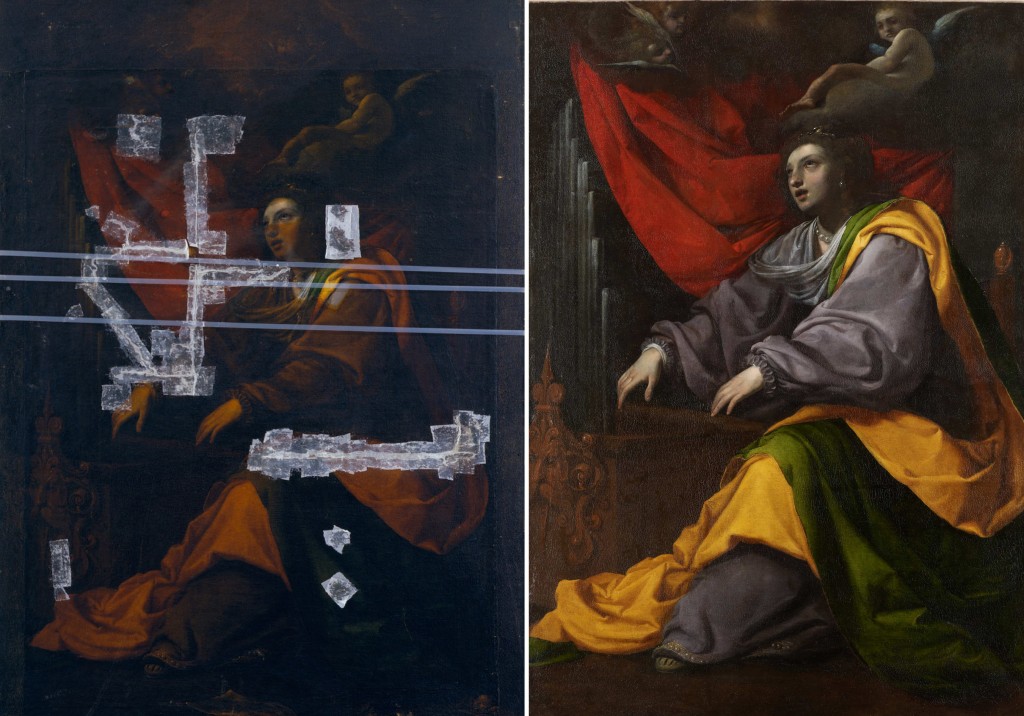The Dulwich Picture Gallery in London unveiled the results of a two-year restoration of Saint Cecilia, a Baroque masterpiece currently attributed to the school of Annibale Caracci. The 17th century painting was in such awful condition that it had been off public display and in storage since the late 19th century. In 2009, sufficient funds were raised to begin a full restoration and it’s taken this long to painstakingly repair tears, reframe and clean the work.
And thus at long last, the sons pay for the sins of the father, for the person who is most responsible for its deplorable condition was Sir Francis Bourgeois, the founder of the Dulwich Picture Gallery. He and his partner Noël Desenfans ran an immensely successful and high-end art dealing business. In 1790 they were commissioned by Stanislaus August, King of Poland (and former lover of Catherine the Great’s), to create a royal collection of important art that would rival those held by the other crowned heads of Europe. Desenfans and Bourgeois worked for five years to put together a world-class art collection from scratch for Poland’s new national gallery.
Unfortunately in 1795 King Stanislaus was forced to abdicate and the country was dismembered by Russia, Prussia and Austria. Thus Desenfans and Bourgeois were left with a national gallery but no nation to put it in. They spent the rest of their lives selling some of the pieces in order to fund the purchase of equally important pieces and to find a place where the collection could go on display in appropriate splendor.
Desenfran died first in 1807. Bourgeois died in 1811 and left the collection to Dulwich College stipulating that the paintings were to go on public display. The Dulwich Picture Gallery was founded that year in accordance with the terms of the will and became the first public art gallery in the United Kingdom. (There was no National Gallery until 1824.)
Saint Cecilia used to hang in Desenfans’ and Bourgeois’ gallery/home. At the time it was attributed to seventeenth-century Bolognese painter Annibale Carracci himself. They hung it next to a Sir Joshua Reynolds painting but since Saint Cecilia was smaller than Mrs Siddons as the Tragic Muse, just for the symmetry of it Bourgeois added wide strips of canvas around the former so that it would look like the two paintings were the same size.
The additions that Bourgeois made, however, eventually started to disintegrate and come away from the original seventeenth-century canvas. Well-known art critic Mrs. Jameson, writing in A Handbook to the public galleries of art in and near London (1842), made the rather scathing observation that she had ‘seldom seen a picture so shamefully maltreated – so patched and repainted…[Sir Francis Bourgeois’s] hand is clearly distinguishable’.
By the end of the century it wasn’t fit to be seen. Now look at it:

Now that it’s so clean and pretty, the question of attribution might be more fruitfully explored. The Gallery has a great deal of data from the conservation process that could help experts pin down whose hand painted Saint Cecilia.
The also have a rather nifty website, btw, with an extensive collection of videos about the paintings in the collection, visiting exhibits and the history of the collection. Check out the Masterpiece of the Month videos. It started in January of this year and will run until December, so you can watch them all back to back. :love: